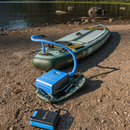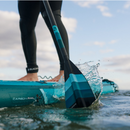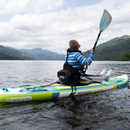Is Paddle Boarding Hard to Learn? Questions Answered

Are you one of those people who've always wanted to try paddle boarding, but the thought of balancing on a board in the water seems daunting? Don't worry, you're not alone.
The truth is, paddle boarding can seem challenging at first, but with a little bit of practice and determination, anyone can learn to paddle board.
In this article, we will answer the question “Is paddle boarding hard?” and take you through the process of learning how to paddle board and show you just how easy and fun it can be.
Is Paddle Boarding Hard?
Paddle boarding is not hard and is considered relatively easy to learn because paddlers can learn enough to have fun in no time with just a little effort. Anyone can learn to handle a SUP board in a short amount of time. Even if you're not very athletic, you can still figure it out without any trouble. It's not necessary to stand the entire time if you prefer not to!
Your knowledge of water sports is one of the most important aspects. For instance, it might be easier for you if you've done other water activities like kayaking or surfing before. But it might take some practice if you're a novice in order to master the coordination and balance needed to stand up and paddle.
Another consideration is the sort of water in which you are paddle boarding. This water sport is simple if the water is calm and flat. It becomes more difficult in choppy or windy conditions, needing more strength and balance to remain upright.
How Hard Is It to Balance on a Paddle Board?
Many paddlers, especially newcomers wonder “How hard is it to paddle board”. Though it might be challenging at first, paddle boarders can grasp the basic skills with the right techniques and a bit of practice.
In order to stand firmly on the board, start by kneeling on the board, then slowly rise to your feet, ensuring your center of gravity is low. Your feet should be shoulder-width apart and centered on the board, with your knees slightly bent. Keeping your eyes fixed on the horizon rather than on your feet helps you stay oriented and reduces the likelihood of seasickness.

A wider board offers more stability and is easier to balance, particularly for those new to the sport. The type of board you select should match your physical characteristics, like height and weight, as well as the conditions you plan to paddle in. Calm, protected waters are the best environment for beginners to practice and build confidence.
Is it Easy to Fall Off a Paddle Board?
To answer the question, "Is paddle boarding difficult?" it's important to recognize that falling off a paddle board is a common part of the learning process, viewed by many as an inevitable aspect of becoming proficient at paddle boarding. No matter your skill level, you're bound to experience falls; however, take these tips to minimize any injuries.

If you find yourself falling off your board, try to fall away from the board to avoid collision with it. Always wear a leash to ensure the board remains within reach and learn the correct technique to climb back on the board.
Paddle Boarding Learning Curve
If you have discovered the perfect answer to the question "Is paddleboarding hard?” then let’s kickstart the adventure with these paddle boarding lessons.
1. Foundation
- Gear Acquaintance:
The first step is familiarizing yourself with the paddle board and paddle. Beginners may find wider, longer boards more stable and forgiving.
- Balance Mastery:
Initial attempts often involve learning to balance on the board in calm, flat water. Beginners learn to stand up, find their center of gravity, and maintain stability, which can be the most challenging part for many.
2. Paddling Techniques
Many people often ask, “Is paddle boarding easy?” The answer largely depends on mastering a few key aspects. Once comfortable with standing on the board, the next focus is on paddling techniques. It starts with how to hold the paddle correctly, stroke efficiently, and steer the board. Paddling techniques also involve learning how to control the board's speed and direction.
3. Safety Practices
Integral to the paddle boarding experience is a strong emphasis on safety. Wearing a life jacket, using a leash, and knowing how to fall safely are non-negotiable. Additionally, being mindful of the weather, water conditions, and potential hazards ensures a safe outing every time.
4. Advancing Skills
As your confidence grows, you'll be ready to explore advanced paddle boarding skills. This could include learning to navigate through choppy water, mastering quick turns, and even trying your hand at SUP yoga or racing.
5. Endurance and Exploration
Building up your endurance allows for longer paddle boarding sessions and the opportunity to explore farther from shore. As you become more comfortable and skilled at paddle boarding, you can venture into different types of water bodies and enjoy various paddle boarding disciplines, from tranquil paddles on a serene lake to adventurous outings in coastal waters.

Common Mistakes Beginners Make
Is it easy to paddle board? It's certainly a wonderful water sport that offers a full-body workout and allows you to immerse yourself in the beauty of nature. However, like any sport, beginners often make certain mistakes that can detract from the overall experience.
1. Standing too Far Back on the Board
Don't stand at the back of the board like you're trying to hide from the waves. Stand about midway on the board, keep those feet shoulder-width apart, point your fingers forward, and keep those legs slightly bent for maximum balance.
2. Paddling Incorrectly
Let's talk about paddling technique. Keep your hands shoulder-width apart, and make sure your arms are straight as you pull that paddle towards you.
And don't forget to engage your core muscles. Your abs will thank you as you power through those waves with ease.
3. Choosing the Wrong Paddle Board Size
Let's not forget about choosing the right board size. Don't go for something too big or too small, or you might end up looking like a floundering fish out of water.
Choose a board that's just right for your weight, skill level, and the type of water you'll be paddling on. And if you're new to this game, start with a wider, longer, and more stable board to get your sea legs before you tackle something more challenging.

Choosing the correct board size can be difficult, so read our guide on "How to Choose the Best Size Paddle Board for Beginners?" for more information.
Tips for Making Paddle Boarding Easier
Is SUP hard to learn? Not necessarily. Here are some straightforward and effective tips that can enhance your stand-up paddleboarding experience
1. Choosing the Right Paddle Board
Stand up paddle boards come in all shapes and sizes, but you'll want to opt for a wider and more stable board as a beginner.

You should also consider the length of the board, as longer boards tend to be more stable and easier to balance. A good beginner board will be at least 10 feet long and 32 inches wide. Once you have your board, you'll need a paddle. Make sure to choose a paddle that is the right size for you and has a comfortable grip.
2. Starting in Calm Waters
Starting in calm waters is crucial for beginners. Waves and currents can make it difficult to balance and control the board, making the experience challenging and frustrating.
Starting in calm waters such as a lake or a sheltered bay will give you a chance to learn and practice the basic techniques of paddle boarding without the added difficulty of waves and currents. It's also important to check the weather forecast before heading out to ensure that conditions are safe and appropriate for your skill level.
3. Practice Getting On the Board
The initial step in your paddle boarding adventure involves getting on the board, which can be a bit tricky at first. Start in shallow water where you can easily stand. Place your paddle across the board, use your hands to stabilize it, and gently lift yourself onto the board in a kneeling position. Once you feel stable, gradually stand up, one foot at a time, and familiarize yourself with the board's balance and movement.
4. Keep Your Feet Parallel
Keep your feet parallel, about hip-width apart, and centered between the edges of the board to maintain stability. Keeping your feet parallel also allows for more efficient power transfer during paddling, enhancing your control over the board.
5. Look at the Horizon
One of the golden rules in many balance-based activities is to look ahead, not down. Avoid looking at your feet; instead, keep your head up and eyes forward for better stability and posture. Focusing on the horizon helps maintain your balance by aligning your body correctly. It promotes a more upright and stable posture for effective paddling and navigating through the water.
6. Use Your Core
Is paddleboarding hard? It might seem challenging at first, especially since it's an excellent core workout. To maintain balance and propel the board forward, you need to engage your core muscles. Engaging your core improves your stability on the board and increases the power and efficiency of your paddle strokes. Remember, the strength comes from your core, not just your arms.
7. Practice Falling & Getting Back On
Falling off the board is an inevitable part of paddle boarding, and practicing how to fall safely can prevent injuries. Aim to fall away from the board to avoid hitting it.
To climb back aboard, start with locating your board (simplified by the leash), positioning yourself alongside it, and doing a mix of leg kicks and arm pulls to return to a prone position on the board. From there, you lie down first and ease yourself back into a standing position, then keep paddling like nothing happened.
8. Take a Lesson
Especially for beginners, taking lessons from qualified instructors can significantly enhance the learning experience. Lessons can cover essential safety information, including how to read water conditions and weather patterns, making your paddle boarding experience more enjoyable and safer.
Embarking on the SUP journey opens up a world of adventure and fitness opportunities. By focusing on these foundational aspects, beginners can quickly gain confidence and skill, allowing them to explore and enjoy the water in new, exciting ways.
Basic Paddle Board Technique You Can Learn in No Time
Beginners may wonder “how difficult is paddle boarding?”, but they'll be relieved to know that with a few basic techniques, they can quickly learn several basic paddle board techniques that will assist them in feeling more at ease on the water.

Ready to become a paddle boarding pro? Here are a few crucial tactics you absolutely need to master to crush it on the water:
- Correct Paddle Holding: Keep your arms shoulder-width apart, bend your shoulders 90 degrees, and make sure that blade is pointed forward at all times. With this grip, you'll be slicing through waves in no time!
- Balance and Stance: Stand in the middle of the board with your feet shoulder-width apart and your toes facing forward. Keep those knees slightly bent and engage your core to keep everything steady. Trust us, you'll look and feel like a natural on the water.
- Paddle Stroke Technique: Reach forward with your top hand and dive that blade into the water. Use your upper body and core strength to power your stroke as you pull that paddle back towards your feet. And don't forget to alternate your strokes on either side of the board to stay on track.
Conclusion
So, is paddle boarding hard? It may take some practice and patience, but with a little determination and a willingness to learn, anyone can enjoy the thrill of paddle boarding.

As a beginner, it's important to choose the right board and paddle and practice in calm waters. Remember to keep your eyes on the horizon, use your core muscles, and don't be afraid to fall. So what are you waiting for? Grab an inflatable paddle board, hit the water, and start paddling today.
Visit iROCKER for more details on paddle boarding equipment.
FAQ
1. Is paddleboarding easy for beginners?
Yes, paddleboarding is relatively easy for beginners. It's known for its gentle learning curve. Many people find they can keep their balance and start paddling comfortably after just a few tries. The key is to start in calm, flat water and to choose a wide, stable board.
2. How long does it take to learn paddle boarding?
The basics of paddle boarding can often be picked up in a single day of practice. Getting comfortable with balancing on the board and handling the paddle usually takes just a few hours of practice. Mastery of more advanced techniques, like efficient stroke form or handling choppy water, will take longer and require regular practice.
3. What are the key skills I need to learn for paddle boarding?
The key skills for paddle boarding include maintaining balance on the board, using the paddle efficiently to move and steer, and understanding safety practices such as how to fall safely and how to get back on the board in deep water.
4. Is it better to start paddle boarding in a certain type of water?
Yes, it's best to start paddle boarding in calm, flat water. Conditions like a quiet lake, a peaceful bay, or a gentle river offer an ideal setting for learning the basics without the challenge of waves or strong currents.
5. Can I teach myself to paddle board?
Many people successfully teach themselves to paddle board. There are numerous online tutorials and videos that offer step-by-step guidance for beginners. However, taking at least one lesson can significantly speed up the learning process and help ensure you're using proper technique, which can improve your experience and reduce the risk of injury.
6. What equipment do I need to start paddle boarding?
To start paddle boarding, you'll need a paddle board (SUP), a paddle, a personal flotation device (PFD), and a leash that connects you to the board. The PFD is a safety requirement in many areas, and the leash ensures that your board doesn't drift away from you if you fall off.
7. Is paddleboarding a good workout?
Absolutely, paddle boarding is an excellent full-body workout. It engages your core muscles as well as your arms, back, and legs. The balance required to stand on the board also means you're constantly engaging muscles throughout your body to stay upright.
8. Can children learn paddle boarding?
Yes, children can learn paddle boarding and often pick it up quickly due to their natural balance and flexibility. It's important to ensure they are supervised, wear a properly fitted PFD, and use equipment suited to their size.
References:
Paddle Outside. (n.d.). Is Paddle Boarding Hard? The Plain Truth. [online] Available at: https://paddleoutside.com/ [Accessed 22 Feb. 2024].
Paddle Board Athlete. (n.d.). How To Get Back On Your Paddle Board After Falling & How To Fall. Retrieved from https://paddleboardathlete.com







